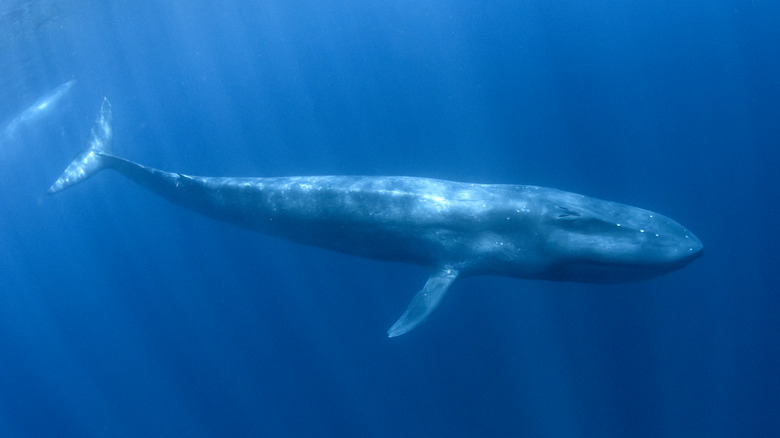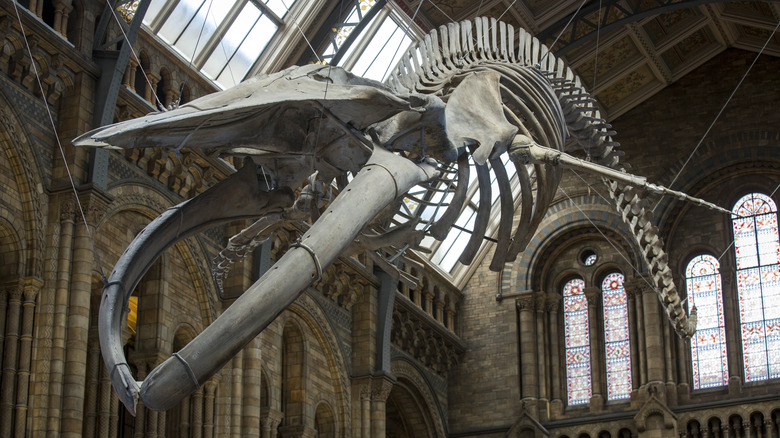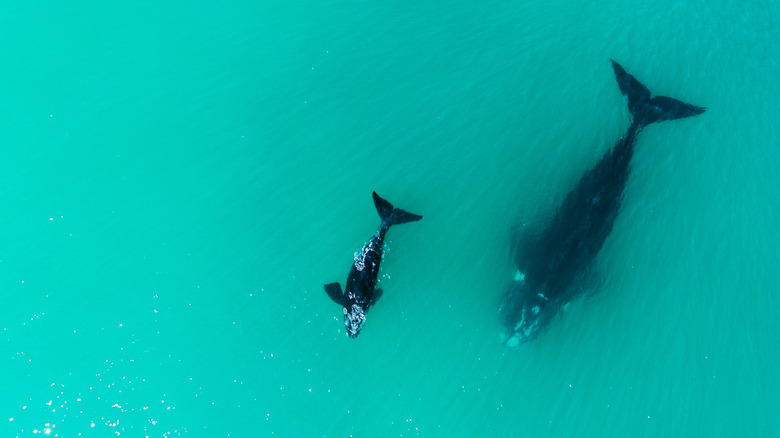A Human Could Easily Fit Inside A Blue Whale's Heart
Narwhals, translating to "corpse whale," are the unicorn whales, so named because the ghostly color of their skin resembles a corpse that has drowned, per National Geographic. Meanwhile, so-called killer whales are not actually whales, but dolphins, so orca is perhaps a more suitable name for the mischievous creatures (via World Wildlife Foundation). Known for toying with their prey and being voracious hunters, a pack of 50 orcas was actually recorded killing a blue whale off the coast of Australia for the first time earlier this year, according to CNN.
Narwhals may be the strangest looking whales and orcas the most ferocious sea mammals, but blue whales are the biggest. Larger than the dinosaurs and any living land mammal, blue whales are the largest creature to have ever inhabited our planet, according to National Geographic. Unfortunately, people began hunting blue whales across the world's oceans for their blubber in the 1900s. In the so-called "era of whaling," as many as 340,000 blue whales were killed in the first half of the 20th century alone, according to the Natural History Museum.
What we know about their hearts
At the Museum of Natural History in Santa Barbara, California, a skeleton of one of these blue whales that died in the 1980s and washed ashore has been preserved. One of five such skeletons preserved in the entire country, the skeleton is enough to make you feel like an ant. Measuring 72-feet long and weighing 7,700 pounds, the blue whale skeleton is named "Chad," after a donor, per the Santa Barbara Museum of Natural History. However, blue whales can stretch up to 100 feet long and weigh more than 200 tons, according to National Geographic.
In order to pump blood to the far corners of this enormous body, blue whales' circulatory systems have to be gigantic too. Their hearts alone are the size of a bear, tiger, or other large mammal, weighing in at 400 pounds, according to Whale Facts. On average, their hearts measure five feet long and four feet wide, the same size of the average woman in the U.S. (per National Geographic, ABC News). That means an adult person could actually fit inside of a blue whale's heart. Theoretically, of course, unless they somehow managed to learn to breathe underwater or swim through all the blood flowing through it.
How they get so big
Baby blue whales come out of the womb big, measuring in at 25 feet and up to three tons at birth, per National Geographic. Then, the babies continue gaining 200 pounds every day for the first year of their life, getting nutrients from their mothers before it's time for them to start hunting like their parents (via National Geographic).
You might think whales use their size to feed on larger animals of the sea, but actually their entire diet is composed almost entirely of krill, small crustaceans they eat up by strolling leisurely through the ocean with a gaping mouth, per National Geographic. Think of Pinocchio's quest into the mouth of the whale to find his father to imagine what it would be like if a whale swallowed you. But instead of escaping and returning to the ocean's surface, up to four tons of krill are ingested and processed through the whale's giant organs each day (via National Geographic).
When hunting for prey and submerged underwater, where they can stay for long stretches of time, a blue whale's heart thumps slowly but strongly at a rate of between two and 10 beats per minute that can be heard from a great distance of more than two miles away, per Whale Facts. Surely, the bum-bum beat of a blue whale's heart from within would be deafening.


